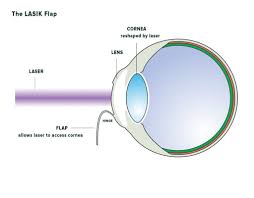Table of Contents
ToggleNo, LASIK does not alter the physical shape of your eye. Instead, it reshapes the cornea, the frontmost layer of your eye, to improve how light is focused onto the retina.
This precise adjustment is what fixes common refractive errors such as myopia, hyperopia, and astigmatism.
While LASIK has revolutionised vision correction for millions, it’s important to understand its scope. The misconception that LASIK changes the overall shape of the eye can lead to confusion, so this article will clarify what LASIK does and does not do, offering a detailed breakdown of its workings. By the end, you’ll have a clear understanding of how LASIK modifies the cornea to restore vision and why it doesn’t change the eye’s full structure.
What Does LASIK Actually Correct?
To better understand why LASIK doesn’t correct the eye’s overall shape, we need to take a closer look at how the procedure works and its target focus.
LASIK Targets the Cornea, Not the Whole Eye
The role of LASIK is to reshape the cornea using a specialised laser. This highly curved, transparent outer layer controls much of the eye’s focusing power by bending incoming light. When your cornea’s shape is irregular, light doesn’t focus correctly on your retina, leading to blurry vision. Here’s how LASIK addresses specific issues:
- Myopia (Nearsightedness): LASIK flattens the cornea’s steep curve, so light focuses correctly on the retina instead of in front of it.
- Hyperopia (Farsightedness): LASIK steepens the cornea’s flat curve, bringing light into focus on the retina instead of behind it.
- Astigmatism: LASIK smooths out uneven corneal curvature to prevent distorted vision.
While the technique is sophisticated, it’s important to note that the procedure only modifies the cornea, not the deeper anatomy of the eye.
Why Doesn’t LASIK Adjust Eye Shape?
Each part of the eye has a specific function, and the eye’s overall structure (including the eyeball) doesn’t need to be manipulated to resolve refractive errors. The cornea’s surface alone determines how light refracts, which is why the correction is limited to this layer. LASIK does not touch other parts of the eye like the lens, retina, or sclera, leaving the spherical shape of the eyeball unchanged.
The Science Behind LASIK and Cornea Reshaping
Understanding how LASIK works reveals why it’s effective without changing the eye’s overall shape.
How the Laser Reshapes the Cornea?
LASIK uses a highly specialised laser, the excimer laser, to reshape the cornea with extreme precision. Here’s how this is done:
- Creating a Flap: The surgeon creates a thin, circular flap on the corneal surface. This flap is folded back to access the underlying corneal tissue.
- Reshaping with the Laser: The laser removes very small amounts of corneal tissue, customising the curvature based on the patient’s vision needs. For example:
- To correct myopia, tissue is removed from the centre of the cornea.
- For hyperopia, tissue is removed around the perimeter.
- Repositioning the Flap: After reshaping, the flap is gently placed back in position to heal naturally without stitches.
The procedure does not affect any other part of the eye, only the cornea’s surface curve, leaving the actual shape of the eyeball intact.
Does LASIK Permanently Change the Cornea?
The cornea retains its new shape permanently after the LASIK procedure because the excimer laser eliminates corneal tissue. However, natural ageing processes and conditions like presbyopia (age-related farsightedness) may still impact vision over time. Importantly, LASIK results are long-lasting but do not alter the structural shape of the eye itself.
How LASIK Improves Vision Without Eye Shape Modification
Refraction vs. Eye Shape
The correction process with LASIK focuses entirely on refraction, not the size or shape of the eye:
- Refraction is about how light bends as it passes through the cornea and lens.
- The eye’s shape, such as whether it is perfectly round or slightly elongated, doesn’t directly affect how LASIK functions. Instead, the procedure adjusts the cornea so light can focus properly on the retina, regardless of the shape or size of the eyeball.
Anatomical Constraints
The anatomical structure of the eye remains stable and sturdy following the LASIK procedure. While the cornea becomes thinner due to tissue removal, its structural integrity doesn’t undermine the overall eye shape, proving that a reshaped cornea is just as strong and functional.
Why Reshaping the Entire Eye Isn’t Necessary?
Many people assume that altering the eye’s shape might improve vision, but this isn’t the case. The human eye is designed to work cohesively, with the cornea serving as the focal adjustment point for LASIK. Modifying the overall spherical structure:
- Could risk damage to vital components like the retina and optic nerve.
- Would bring unnecessary complications when the cornea alone can resolve vision errors.
Common Misconceptions About LASIK and Eye Shape
Misconception 1: LASIK Shrinks or Enlarges the Eyeball
One prevailing myth is that LASIK alters the eye’s length or diameter, particularly in cases of myopia or hyperopia. However, the eyeball’s overall shape remains untouched. Instead, LASIK compensates for the eye’s natural physical shape by adjusting how light is focused.
Misconception 2: LASIK Fixes Irregular Eye Shapes
While LASIK can correct astigmatism, which is caused by an irregularly shaped cornea, it doesn’t fix conditions where the eyeball shape is irregular (e.g., elongated eyeballs causing high myopia). Conditions involving the entire eyeball shape, like keratoconus or severe abnormalities, generally require other treatments, such as corneal transplants or specialty lenses.
Misconception 3: LASIK Changes Eye Appearance
LASIK has no visible impact on the overall look of your eyes. While the corneal shape is slightly adjusted, the change is microscopic and invisible to the naked eye. Your eye’s external appearance remains the same post-procedure.
Who is LASIK Best For?
LASIK works best for individuals who:
- Have a stable vision for at least a year.
- Are dealing with common refractive errors like myopia, hyperopia, or astigmatism.
- Have corneas thick enough to withstand the reshaping process.
It’s not suitable for those looking to physically modify their eyes’ structure or for individuals with severe eye health issues outside refractive errors.
Final Thoughts on LASIK and Eye Shape
LASIK doesn’t change the overall shape of your eye; it reshapes your cornea to correct vision errors. By understanding its scope, you can make more informed decisions if you’re considering the procedure. Instead of modifying the eye’s total anatomy, LASIK works with precision on the cornea, ensuring your vision is clearer without unnecessary complexity.
For more questions about how LASIK works and whether it’s right for you, consult a qualified eye care provider. They’ll help determine if you’re a good candidate and guide you through the process.













